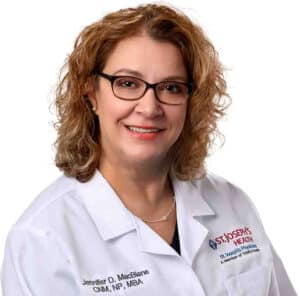By Jolene Cleaver

When it comes to weighing the benefits or risks of hormone replacement therapy, healthcare providers advise women to recognize their individuality and not be afraid to adjust their treatment plan when it comes to achieving a healthcare goal.
In Good Health recently caught up with women’s healthcare providers to discuss the therapy. Weighing in on the subject are nurse practitioner Jennifer D. MacBlane from St. Joseph’s Primary Care Center OB-GYN; Elizabeth Cramer, a family nurse practitioner and Jacqueline Hewitt, a women’s health nurse practitioner, both with Bassett Healthcare Network.
Q: What are the potential risks and benefits of systemic hormone therapy for patients across all ages and health profiles? Are there special considerations for those experiencing early menopause, surgical menopause or breast cancer history?
MacBlane: “The risks of hormone replacement therapy (HRT) can include blood clots, stroke, heart disease, gallbladder disease and breast and uterine cancer. These risks increase for those with additional risk factors like obesity, heart disease, clotting disorders and diabetes. Hormone replacement therapy can benefit menopausal women by lessening symptoms such as hot flashes, night sweats, insomnia, mood swings, anxiety, vaginal dryness, and skin changes. These benefits can make the menopause period more manageable and make women feel like their ‘normal selves’. More importantly, though, HRT can have a profound impact on medical risks for menopausal women like improved bone density (less risk of fractures), and heart health benefits. New research shows HRT may also affect the risk for diabetes and dementia. Risk of complications increase based on factors such as length of time since menopause occurred, and age starting the therapy. Women over 60 that start on hormone therapy are less likely to achieve the benefits of HRT.”

Cramer and Hewitt: “There are many benefits to menopause hormone therapy (MHT), when given to the right patient at the right time. Hormones improve quality of life by treating symptoms such as hot flashes, night sweats, joint pain, vaginal dryness, mood changes and sleep. If MHT is started within 10 years of menopause, studies show it significantly reduces the risk of heart disease. This is known as the ‘timing hypothesis.’
“There is growing evidence that if MHT is started within the 10 years of menopause it may lower the risk of Alzheimer’s disease and dementia. We also have evidence MHT decreases the risk of colorectal cancer, Type 2 diabetes, fractures and osteoporosis.
“There is a common fear of MHT causing breast cancer but there are a lot of nuances that need to be explained to help understand this. We have good data from large studies like the Women’s Health Initiative that showed for estrogen-only therapy there was no increased risk of breast cancer and, in some cases, there was a lower risk. For combined estrogen-progestin therapy there was a slight increased risk in breast cancer. But the key is that the absolute risk is very small and comparable to other lifestyle risks like being sedentary, overweight, or drinking two alcoholic drinks per night. It is also important to note that this data came from a large study that used synthetic hormones that we do not commonly prescribe.
“Some forms of MHT can increase the risk of blood clots but the type, route and timing of initiation of a MHT matters greatly. Oral estrogen can increase the risk of venous blood clots (deep vein thrombosis, leg; pulmonary embolism, lungs). The highest risk is the first 1-2 years of starting therapy and is more concerning if started more than 10 years after menopause (again the timing hypothesis).

“Transdermal estrogen (patches, gels, spray) do not significantly increase the risk of blood clots. These forms bypass the liver avoiding the clotting effect seen with oral estrogen. They are the preferred route for women at higher risk of blood clots. We need to put the risk in context – the risk of oral estrogen is lower than the risk of taking hormonal birth control and much lower than the risk of a blood clot during a normal pregnancy. The absolute risk of a blood clot in a healthy woman within 10 years of menopause is still very low.
“The bottom line is if you are healthy and within 10 years of menopause the risk of a blood clot with MHT is very small, especially if you are using a transdermal formulation. For many women the benefits far outweigh that risk. You need to work with a provider who knows how to individualize your menopause care. The research is clear that in women who experience premature menopause (before 40) or early menopause (40-44) there is an increased risk of early cardiovascular disease and bone deterioration (osteoporosis). These women should be counseled by their provider on these risks and if safe offered MHT.
“In general, for women who cannot take hormone therapy we can find a safe nonhormonal option to help manage their menopause symptoms. Active breast cancer treatment and high cardiovascular risk are contraindications to hormone therapy.”
Q: What’s the best way to compare different types of hormones and delivery methods (pill, patch, gel, etc.).
MacBlane: “There are different types of HRT including: pills, patches, vaginal creams and gels and vaginal rings or suppositories. Women should choose options within their comfort level (for example using vaginal suppository) that have the most affect on the symptoms they are experiencing. Together with a provider they can choose the option that would work best. Any type of HRT is done through trial and error. Women should meet with their provider while trialing different options until they achieve a reduction in the symptoms they are experiencing. It is important to note that women that still have their uterus intact need to take a combined HRT with both estrogen and progesterone. Estrogen alone has been known to increase the uterine lining and can increase the risk of uterine cancer.”
Cramer and Hewitt: “This is a great discussion point for each person to have with their own provider. Many factors play into why someone may be better suited to one formulation over the other. In general, transdermal formulations have a better safety profile in terms of the risk of developing venous thromboembolism (blood clots). This is why we tend to recommend the patch (once or twice weekly), gel or spray (both given daily) over the pill. However, we recognize each woman’s individuality, and patient preference plays a part in prescribing decisions.”
Q: How long should women stay on hormone therapy, and what is the best way to monitor hormonal response and adjust if needed?
MacBlane: “The length of HRT will be determined between the woman and her provider. The length of treatment will depend on severity of the symptoms, preexisting risk factors (like cancer risk or cardiac problems), and the type of replacement therapy. Typically, HRT is recommended for 2-5 years, though some women may continue longer if still symptomatic. Women should have regular gynecological appointments to monitor the response to treatment and if the medication needs to be changed. It is important if a woman’s health status changes (like high blood pressure) that she notify her GYN provider to discuss if a change needs to be made in her HRT.”
Cramer and Hewitt: “Hormonal response is monitored through symptoms, not labs. The best way to find the best dose and make necessary adjustments is through routine follow up appointments. Perimenopause (the years leading up to the final menstrual period) is characterized by large fluctuations in hormone levels and can be challenging to treat; the ideal hormone dose is often a moving target, so seeing patients back for frequent follow up every few months is crucial to optimize treatment. Regarding length of treatment, this should be discussed annually, with review of any new health conditions, a calculation of the patient’s current cardiovascular disease risk, and a mutual discussion of the risks and benefits of continuing. Some patients remain on hormone therapy for life.”

